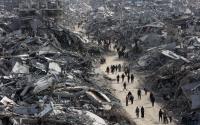29 December 2004Justin Huggler in Madras and Andrew Buncombe
On any other day, the children would have been at school or the poorer ones at work. But on a balmy Sunday morning, the beach in Madras was alive with children doing what they did every week - playing cricket. Then the water came.
Everyone here has a story. All can tell how the tsunami swallowed their children, sweeping them out to sea. Maran saw his niece Velankani dragged away from him. He said: "I was trying to grab hold of her, but the sea pulled her out of my arms.We were all trying to grab hold of the children but no one could do anything."
For Magesh, it was his sister Elizabeth and her seven-year-old daughter Martina. He said: "I could see them. Then suddenly the water came and they were gone."
The cruelty was in the timing. Kapaliswaram, a policeman, described the scene: "There were kids playing cricket right out at the edge of the sea. Nobody round here knows who they were. No trace of their bodies has been found." Fishermen told how they had been swept away but had been able to swim back. The children could not. Nor could they run fast enough to escape.
The walls of water sent crashing onto the coasts of south Asia by the biggest earthquake in 40 years took a disproportionate number of young lives. It may have been as many as half of the victims - the toll stood at 60,000 last night. As the calmer waters return a steady flow of bodies, communities are coming to terms with a lost generation.
Mike Kiernan, a spokesman for Save the Children in Washington, said: "The death toll among children in these disasters is always high, especially in the poorest parts of the world - that is one of the tragedies. In villages such as Cuddalore in India we know that more than half of the 400 victims were children. There will also likely be many thousands of children orphaned." Waterborne diseases such as typhoid and cholera, as well as malaria, would take their toll on the youngest and weakest survivors, he warned.
A spokesman for the United Nations children's fund Unicef said that up to half of those killed could have been children. Communities were suffering a double loss: dead children, and orphaned boys and girls. He said: "Our major concern is that the kids who survived, now survive the aftermath. Children are the most vulnerable to disease and lack of proper nutrition and water."
Petra Nemcova, a Czech model, described the impact in the Thai resort of Khao Lak. "This huge wave pulled us out of the house. People were screaming and kids were screaming 'Help! Help!' After a few minutes you didn't hear the kids any more." Ms Nemcova's boyfriend, the photographer Simon Atlee, is one of many missing Britons.
In the Indonesian city of Banda Aceh, the playing fields were strewn with more than 1,000 corpses, hundreds of them children. They died where they had played. Mahmud Azaf, who lost all three of his own children, said: "I was on the field as a referee. The waves suddenly came in and I was saved by God - I got caught in the branches of a tree."
Unicef says the next few days will be critical. "We're concerned about providing safe water, which is urgent in all these countries, and about preventing the spread of disease," a spokesman said.
Another threat to survivors in Sri Lanka is landmines dislodged by floodwaters. A spokesman for Unicef said: "Mines have been washed out of known minefields and warning signs on mined areas have been swept away or destroyed. The greatest danger to civilians will come when they return to their homes, not knowing where the mines are."
Laura Conrad, a spokeswoman for Save the Children in London, said that aid groups had long-established projects in Sri Lanka to try to help reunite children and their families who had been separated by the long-simmering civil war.
Along with their counterparts in other countries, they will face a massive task. Down the coast from Madras, in Cuddalore, people were digging two mass graves. According to Hindu tradition, adults are cremated, but the bodies of children are buried. In Cuddalore there was more demand for burials than cremations.
The smell of disinfectant hangs over the beach at Sri Niwasa Puram in Madras. Twenty bodies were washed ashore here, and the authorities were trying to clean up. But many other bodies have disappeared. Maran found the body of his niece, but has been unable to find his grandmother and sister, who he also saw washed out to sea. This is India's fourth largest city, a teeming metropolis that epitomises much of the spirit of the new, economically thriving India. But where Madras meets the sea yesterday, that city disappeared, and there were only crowds who gathered at the devastated beaches.
Heading south down the coast from Madras, it gets worse. In Cuddalore, 13 villages were destroyed. In the small district of Nagapattinam alone, 2,500 people are believed dead. As the survivors spoke yesterday, you could still feel aftershocks from the great earthquake. Everybody here felt the earthquake, but nobody knew it was a terrible sign of danger. In Sri Lanka, there were even reports that many children went to the beach in excitement to see the huge waves.
All along the sea front in Madras, the people sat in little huddled groups staring out to sea. The beach is littered with broken pieces of fishing boats. Stray dogs huddle into the mounds of old clothes donated for survivors. But the people do not see any of that. They are still replaying the events they saw that day, when the sea took their children from them.






